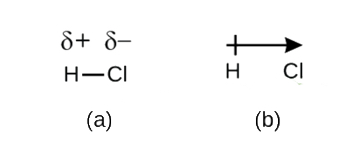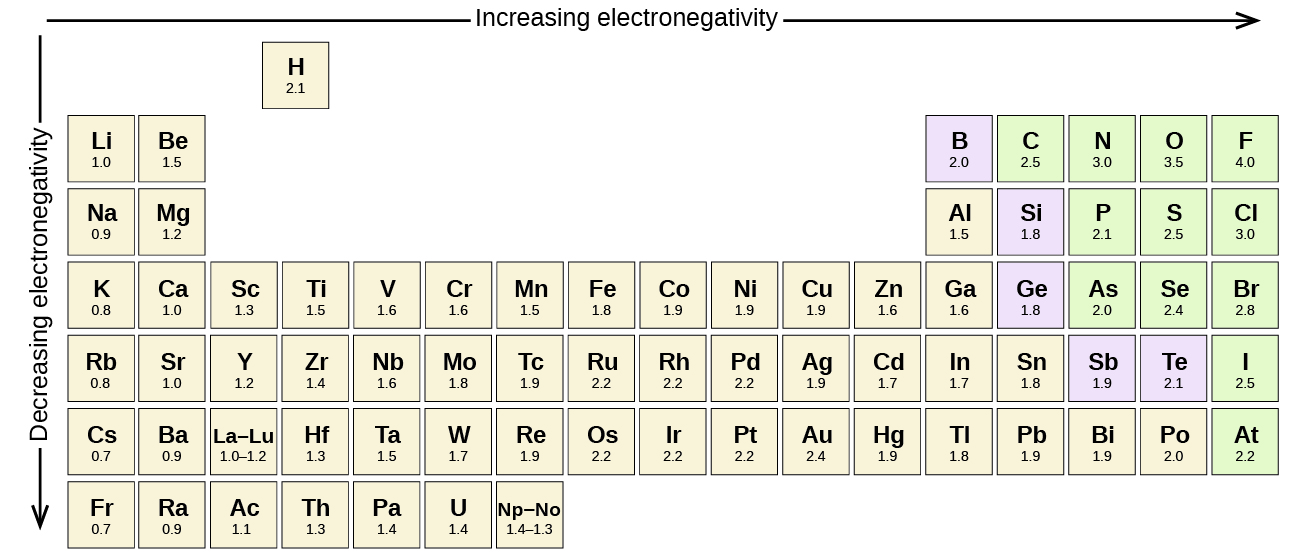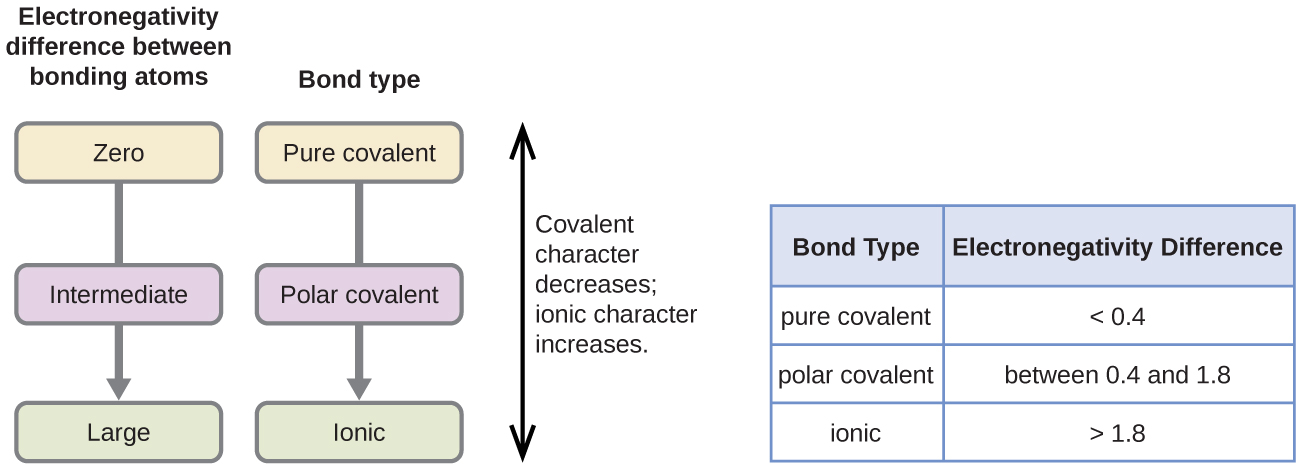5.6: Polarity of Bonds
- Page ID
- 313256
Electronegativity and Bond Polarity
Although we defined covalent bonding as electron sharing, the electrons in a covalent bond are not always shared equally by the two bonded atoms. Unless the bond connects two atoms of the same element, as in H2, there will always be one atom that attracts the electrons in the bond more strongly than the other atom does, as in HCl, shown in Figure \(\PageIndex{1}\). A covalent bond that has an equal sharing of electrons (Figure \(\PageIndex{1a}\)) is called a nonpolar covalent bond. A covalent bond that has an unequal sharing of electrons, as in Figure \(\PageIndex{1b}\), is called a polar covalent bond.

The distribution of electron density in a polar bond is uneven. It is greater around the atom that attracts the electrons more than the other. For example, the electrons in the H–Cl bond of a hydrogen chloride molecule spend more time near the chlorine atom than near the hydrogen atom. Note that the shaded area around Cl in Figure \(\PageIndex{1b}\) is much larger than it is around H.
This imbalance in electron density results in a buildup of partial negative charge (designated as δ−) on one side of the bond (Cl) and a partial positive charge (designated δ+) on the other side of the bond (H). This is seen in Figure \(\PageIndex{2a}\). The separation of charge in a polar covalent bond results in an electric dipole (two poles), represented by the arrow in Figure \(\PageIndex{2b}\). The direction of the arrow is pointed toward the δ− end while the + tail of the arrow indicates the δ+ end of the bond.

Figure \(\PageIndex{2}\): (a) Unequal sharing of the bonding pair of electrons between H and Cl leads to partial positive charge on the H atom and partial negative charge on the Cl. Symbols δ+ and δ– indicate the polarity of the H–Cl bond. (b) The dipole is represented by an arrow with a cross at the tail. The cross is near the δ+ end and the arrowhead coincides with the δ–.
Any covalent bond between atoms of different elements is a polar bond, but the degree of polarity varies widely. Some bonds between different elements are only minimally polar, while others are strongly polar. Ionic bonds can be considered the ultimate in polarity, with electrons being transferred rather than shared. To judge the relative polarity of a covalent bond, chemists use electronegativity, which is a relative measure of how strongly an atom attracts electrons when it forms a covalent bond. There are various numerical scales for rating electronegativity. Figure \(\PageIndex{3}\) shows one of the most popular—the Pauling scale.

The polarity of a covalent bond can be judged by determining the difference in the electronegativities of the two atoms making the bond. The greater the difference in electronegativities, the greater the imbalance of electron sharing in the bond. Although there are no hard and fast rules, the general rule is if the difference in electronegativities is less than about 0.4, the bond is considered nonpolar; if the difference is greater than 0.4, the bond is considered polar. If the difference in electronegativities is large enough (generally greater than about 1.8), the resulting compound is considered ionic rather than covalent. An electronegativity difference of zero, of course, indicates a nonpolar covalent bond.

Example \(\PageIndex{1}\)
Describe the electronegativity difference between each pair of atoms and the resulting polarity (or bond type).
- C and H
- H and H
- Na and Cl
- O and H
Solution
- Carbon has an electronegativity of 2.5, while the value for hydrogen is 2.1. The difference is 0.4, which is rather small. The C–H bond is therefore considered nonpolar.
- Both hydrogen atoms have the same electronegativity value—2.1. The difference is zero, so the bond is nonpolar.
- Sodium’s electronegativity is 0.9, while chlorine’s is 3.0. The difference is 2.1, which is rather high, and so sodium and chlorine form an ionic compound.
- With 2.1 for hydrogen and 3.5 for oxygen, the electronegativity difference is 1.4. We would expect a very polar bond. The sharing of electrons between O and H is unequal with the electrons more strongly drawn towards O.
Exercise \(\PageIndex{1}\)
Describe the electronegativity (EN) difference between each pair of atoms and the resulting polarity (or bond type).
- C and O
- K and Br
- N and N
- Cs and F
- Answer a:
-
The EN difference is 1.0 , hence polar. The sharing of electrons between C and O is unequal with the electrons more strongly drawn towards O.
- Answer b:
-
The EN difference is greater than 1.8, hence ionic.
- Answer c:
-
Identical atoms have zero EN difference, hence nonpolar.
- Answer d:
-
The EN difference is greater than 1.8, hence ionic.
Exercises
-
Using Figure \(\PageIndex{3}\), determine which atom in each pair has the higher electronegativity.
- H or C
- O or Br
- Na or Rb
- I or Cl
-
Using Figure \(\PageIndex{3}\), determine which atom in each pair has the lower electronegativity.
- Mg or O
- S or F
- Al or Ga
- O or I
-
Will the electrons be shared equally or unequally across each covalent bond? If unequally, to which atom are the electrons more strongly drawn?
- a C–O bond
- an F–F bond
- an S–N bond
- an I–Cl bond
10. Will the electrons be shared equally or unequally across each covalent bond? If unequally, to which atom are the electrons more strongly drawn?
- a C–C bond
- a S–Cl bond
- an O–H bond
- an H–H bond
11. Arrange the following bonds from least polar to most polar: H-F, H-N, H-O, H-C
12. Arrange the following bonds from least polar to most polar: C-F, C-N, C-O, C-C
Answers
1. Using Figure \(\PageIndex{3}\), determine which atom in each pair has the higher electronegativity.
- C
- O
- Na
- Cl
2. Using Figure \(\PageIndex{3}\), determine which atom in each pair has the lower electronegativity.
- Mg
- S
- Al
- I
3. Will the electrons be shared equally or unequally across each covalent bond? If unequally, to which atom are the electrons more strongly drawn?
- unequally toward the O
- equally
- unequally toward the N
- unequally toward the Cl
4. Will the electrons be shared equally or unequally across each covalent bond? If unequally, to which atom are the electrons more strongly drawn?
- equally
- unequally toward the Cl
- unequally toward the O
- equally
5. The electronegativity difference increases from 0.4; 0.9; 1.4; 1.9. Hence, the least to most polar: H-C, H-N, H-O, H-F
6. The electronegativity difference increases from 0; 0.5; 1.0; 1.5. Hence, the least to most polar: C-C, C-N, C-O, C-F

